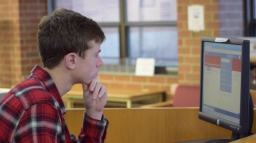Story highlights
Huntley High School in Huntley, Illinois, offers a blended learning program
It allows students to combine online learning with in-person teacher instruction
Most days, 16-year-old Jason Zobott walks into Huntley High School in suburban Chicago around 7:30 a.m. like any high schooler might. It’s what he does the rest of the day that’s not so typical.
Zobott is enrolled in Huntley High’s blended learning program, which merges Internet-based instruction with a more traditional classroom setting. One-third of the school’s 2,700 students are enrolled. In 2015, the school is working toward enrolling the majority of its students.
“Having to work online makes it really accessible to do the work that I have to get done,” said Zobott, a top-ranked junior who balances a heavy load of extracurricular activities with schoolwork. “I can learn on my own. I can work at the pace I want to work. And I learn the way I want to learn.”
Huntley High School students and educators often refer to the program simply as “blended.” It allows teachers to write the curriculum, with students giving feedback about the focus. Unlike many traditional online learning programs, students have the option of a flexible schedule during allotted blended learning days. Some days they meet with teachers, and some days they work online, according to Anne Pasco, who heads the school’s educational technology efforts.

“In blended learning, we focus on the content. We don’t focus on needing to cover X amount of material,” Pasco said. “Blended allows us to provide a stable environment that gives students the ability to spread their wings a bit, while we have the safety net of pulling them back into class if they need it.”
The “homegrown” program, which launched in 2011, gives students who struggle in certain content areas more one-on-one time with teachers during the school day, Pasco said.
“Before blended, that had to happen after school or before school or on Saturday or maybe not at all, because we had too many other activities that encroach upon (students’) academic day,” Pasco said. “Now, this student can work one-on-one with that teacher during the school day.”
Teachers can monitor students’ progress and track lesson plans online to see how much time students spend on a specific assignment. Teachers are allowed to restructure the class schedule based on students’ needs.
“There’s actually much better accountability,” said John Burkey, the superintendent for Huntley High’s school district, which includes about 9,500 students.
“Blended learning is not a panacea, and the success of the program isn’t about spending a bunch of money on technology. Rather, [it’s] looking at what students actually need, and building a culture of innovation to meet those needs.”
Burkey said there were plenty of questions about blended learning when it was first introduced to the Chicago district in 2011. One concern: How was the district going to pay for it?
It turns out the blended learning program spends about $8,500 per student, less than the Illinois average of $12,000 per student.
“We spend considerably less than the average school district. We don’t have a lot of resources compared to many districts,” Burkey said.
“We did not put new money into this. What we did is change the old things we were doing and changed them into new ways. It’s really a change in how you think of high school. This is not a more expensive option.”
It has worked. In a study published in 2014 in eLearn magazine, 92% of students surveyed at Huntley High said that they were satisfied with the blended learning experience, and no teachers reported negative experiences with it. The school is also seeing higher standardized testing scores.
“The growth of blended certainly has corresponded with an overall rise in ACT scores,” district spokesman Dan Armstrong said. Since blended learning was implemented, Huntley High’s average composite ACT score has gone up nearly a point, from 22.1 to 23.0.
For 16-year-old Zobott, the advantage is time management. Three of his courses are advanced placement. He also plays varsity basketball and club soccer and works part time. The blended learning program helps him better prioritize his busy schedule.
“Having blended gives us time to work on them, and get stuff done efficiently so we have more time during the week to do other things,” he said.
What’s still left to be determined about blended learning is how well students do in college or jobs after they graduate, Burkey said.
“I think we’re still in the infancy of this,” Burkey said. “It’s still such a new thing, and we’re all excited about it. My own kids are still in elementary and middle school, so they have not done blended learning yet, but they definitely will when they get to high school.”

